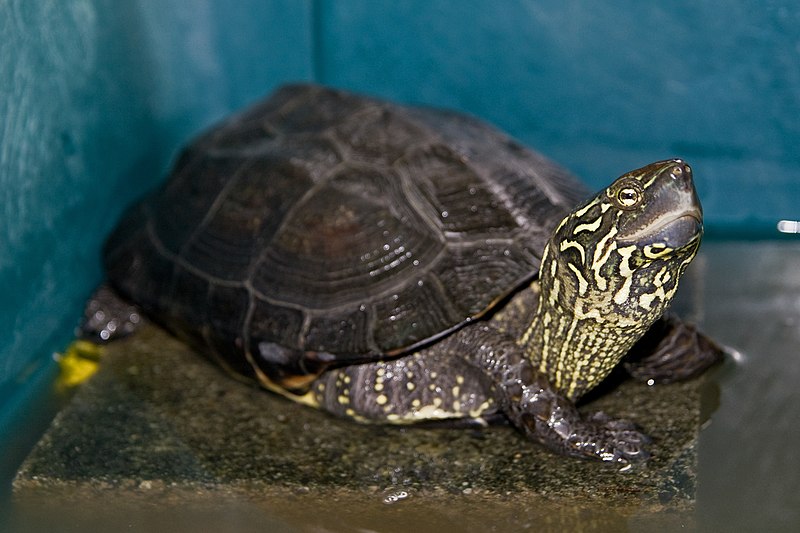 Asia’s freshwater turtles face an unprecedented extinction crisis, which may soon result in the loss of 90 or more species. In 2001, I joined other turtle enthusiasts in south Florida to help process nearly 10,000 turtles of many species that had been confiscated on route to food markets in China. The magnitude of the response to their plight heartened me, but today, unfortunately, we are still fighting an uphill battle. Please see Part 1 of this article for details. Following is a bit more on this sad situation. Read More »
Asia’s freshwater turtles face an unprecedented extinction crisis, which may soon result in the loss of 90 or more species. In 2001, I joined other turtle enthusiasts in south Florida to help process nearly 10,000 turtles of many species that had been confiscated on route to food markets in China. The magnitude of the response to their plight heartened me, but today, unfortunately, we are still fighting an uphill battle. Please see Part 1 of this article for details. Following is a bit more on this sad situation. Read More »
Category Archives: Reptile and Amphibian Health
Feed SubscriptionNew Product – Artificial Bromeliads as Poison Frog Breeding Sites – Part 1
 Today I’d like to introduce Hagen’s Smart Plants, a new line of artificial plants that hold great promise for those keeping Poison Frogs (Dendrobates, Phyllobates, etc.) and arboreal snakes, tarantulas, crabs and similar creatures. Read More »
Today I’d like to introduce Hagen’s Smart Plants, a new line of artificial plants that hold great promise for those keeping Poison Frogs (Dendrobates, Phyllobates, etc.) and arboreal snakes, tarantulas, crabs and similar creatures. Read More »
Inexpensive Homes for American Toads and Their Relatives

Enclosure
Toads spend their time on and below the ground, so floor space is the most important consideration. Read More »
The Asian Turtle Crisis – a Sobering Update – Part 1
 The term “Asian Turtle Crisis” was coined in 1997, when photos of thousands of rare turtles being slaughtered in a Guangzhou, China food market propelled the tragic plight of Asia’s freshwater turtles into the conservation spotlight. The private turtle-keeping and zoo communities were quick to take action, and a number of fine organizations and programs resulted. In 2001, I traveled to south Florida to help rehabilitate and place 7,500-10,000 turtles that had been confiscated in China.
The term “Asian Turtle Crisis” was coined in 1997, when photos of thousands of rare turtles being slaughtered in a Guangzhou, China food market propelled the tragic plight of Asia’s freshwater turtles into the conservation spotlight. The private turtle-keeping and zoo communities were quick to take action, and a number of fine organizations and programs resulted. In 2001, I traveled to south Florida to help rehabilitate and place 7,500-10,000 turtles that had been confiscated in China.
Hard Work Pays Off
In south Florida I worked day and night alongside dedicated folks from the New York Turtle and Tortoise Society and other herp-oriented organizations, internationally-known turtle biologists, private turtle fanciers and zoo colleagues. The marathon effort was a grand success, with more turtles saved and placed in good homes than anyone would have dared hope upon first seeing their wretched condition. Given the passion, funds and other support that the situation aroused, the future looked promising. Unfortunately, 9 years later, the situation remains very bleak.
90+ Species Face Extinction
Recent studies by Conservation International (please see this article) reveal that at least 1/3 of the world’s 280 turtle species, including most of those found in Southeast Asia, are in imminent danger of extinction. Two photos on the homepage of the NY Turtle and Tortoise Society, taken 12 years apart in Guangzhou, China food markets, illustrate, graphically and tragically, that little has changed.
 Several turtle species are represented by single populations numbering 12-50 individuals; only 4 specimens of the Red River Giant Softshell (Rafetus swinhoei, please see photo) are known to exist, the status of many Asian Box Turtles (Cuora spp., please see photo) can not even be determined, but several species have not been seen in years…the list goes on.
Several turtle species are represented by single populations numbering 12-50 individuals; only 4 specimens of the Red River Giant Softshell (Rafetus swinhoei, please see photo) are known to exist, the status of many Asian Box Turtles (Cuora spp., please see photo) can not even be determined, but several species have not been seen in years…the list goes on.
In Part 2 of this article we’ll take a look at the causes of the recent catastrophic declines in turtle populations and what is being done to reverse the trend.
Further Reading
Excellent article on the status of Asia’s turtles along with disturbing photos from food markets in China – READ THIS!
Turtle Survival Alliance Programs
Cuoras Species Headshots image referenced from wikipedia and originally posted by Torsten Blanck
Florida Burmese Python Study – Snakes Cannot Survive South Carolina Winter
 In 2008, a computer-based study by the US Geological Survey stated that Florida’s introduced Burmese Pythons (Python molurus bivittatus) might colonize up to 1/3 of the United States in time. While the snakes’ presence in Florida is a severe problem, the release of this study generated a flood of illogical fears and predictions. Recently, another study conducted by a noted herpetologist and utilizing live snakes has injected some sanity into the controversy. Read More »
In 2008, a computer-based study by the US Geological Survey stated that Florida’s introduced Burmese Pythons (Python molurus bivittatus) might colonize up to 1/3 of the United States in time. While the snakes’ presence in Florida is a severe problem, the release of this study generated a flood of illogical fears and predictions. Recently, another study conducted by a noted herpetologist and utilizing live snakes has injected some sanity into the controversy. Read More »
 That Reptile Blog – Reptile, Amphibian and Exotic Pet Care and Information
That Reptile Blog – Reptile, Amphibian and Exotic Pet Care and Information
